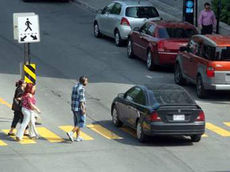New research from AAA reveals that automatic emergency braking systems with pedestrian detection perform inconsistently, and proved to be completely ineffective at night. An alarming result, considering 75 percent of pedestrian fatalities occur after dark. The systems were also challenged by real-world situations, like a vehicle turning right into the path of an adult. AAA’s testing found that in this simulated scenario, the systems did not react at all, colliding with the adult pedestrian target every time. For the safety of everyone on the road, AAA supports the continued development of pedestrian detection systems, specifically when it comes to improving functionality at night and in circumstances where drivers are most likely to encounter pedestrians.
On average, nearly 6,000 pedestrians lose their lives each year, accounting for 16 percent of all traffic deaths, a percentage that has steadily grown since 2010.
So far this year, 156 pedestrians have died as a result of vehicle strikes in North Carolina, compared to 150 in 2018. South Carolina pedestrian fatalities are on pace with last year's numbers - with 116 to date.
“With pedestrian deaths rising across the Carolinas, it’s encouraging to see more vehicles with safety systems on the road that can help reduce these fatalities,” said Tiffany Wright, AAA Carolinas spokesperson. “However, these systems aren’t 100 percent foolproof, and it’s important to stress that motorists need to focus and avoid distractions behind the wheel at all times.”
While time of day and location are contributing factors to pedestrian fatalities, vehicle speed also plays a major role. Previous research from the AAA Foundation for Traffic Safety found that pedestrians are at greater risk for severe injury or death the faster a car is traveling at the time of impact. For example, a pedestrian hit by a vehicle traveling at 20 mph has an 18 percent risk of severe injury or death. Increase that by just 10 mph to 30 mph and the risk more than doubles to 47 percent. AAA’s latest study found that speed impacted system performance as well, with results varying between testing performed at 20 mph and 30 mph.
AAA evaluated the performance of four midsize sedans equipped with automatic emergency braking with pedestrian detection to determine the effectiveness of these systems. Testing was conducted on a closed course using simulated pedestrian targets for the following scenarios:
- An adult crossing in front of a vehicle traveling at 20 mph and 30 mph during the day and at 25 mph at night.
- A child darting out from between two parked cars in front of a vehicle traveling at 20 mph and 30 mph.
- A vehicle turning right onto an adjacent road with an adult crossing at the same time.
- Two adults standing along the side of the road with their backs to traffic, with a vehicle approaching at 20 mph and 30 mph.
Overall, the systems performed best in the instance of the adult crossing in front of a vehicle traveling at 20 mph during the day. In this case, the systems avoided a collision 40 percent of the time. But, at the higher speed of 30 mph, most systems failed to avoid a collision with the simulated pedestrian target. The other scenarios proved to be more challenging for the systems:
- When encountering a child darting from between two cars, with the vehicle traveling at 20 mph, a collision occurred 89 percent of the time.
- Immediately following a right hand turn, all of the test vehicles collided with the adult pedestrian.
- When approaching two adults standing alongside the road, with the vehicle traveling at 20 mph, a collision occurred 80 percent of the time.
- In general, the systems were ineffective in all scenarios where the vehicle was traveling at 30 mph.
- At night, none of the systems detected or reacted to the adult pedestrian.
It is a driver’s responsibility to yield to pedestrians, but those traveling by foot should be diligent as well. Pedestrians should use caution by staying on sidewalks and using crosswalks as often as possible. Always obey traffic signals, look both ways before crossing the street and do not walk and text.
